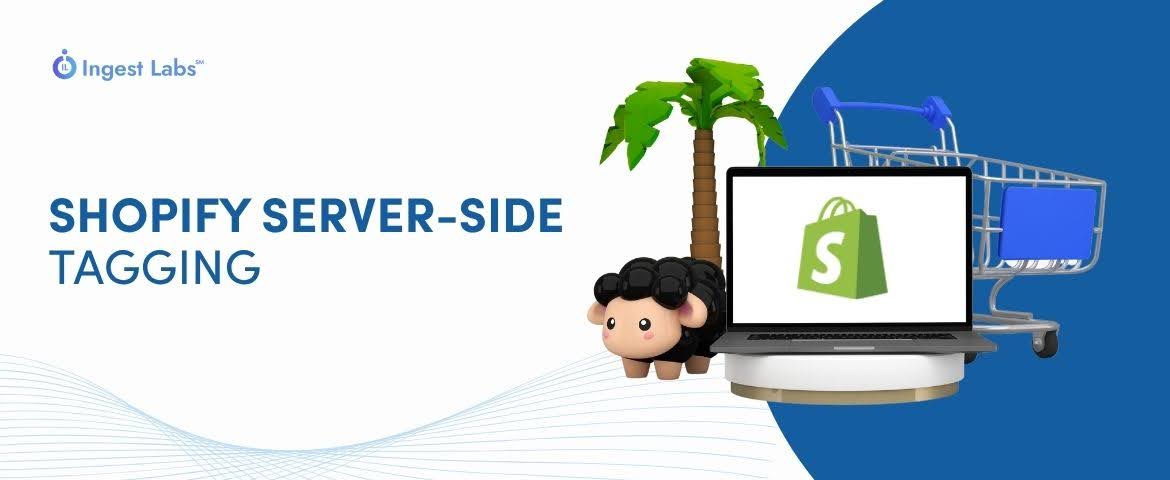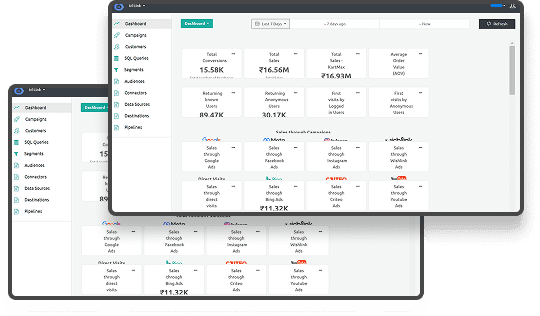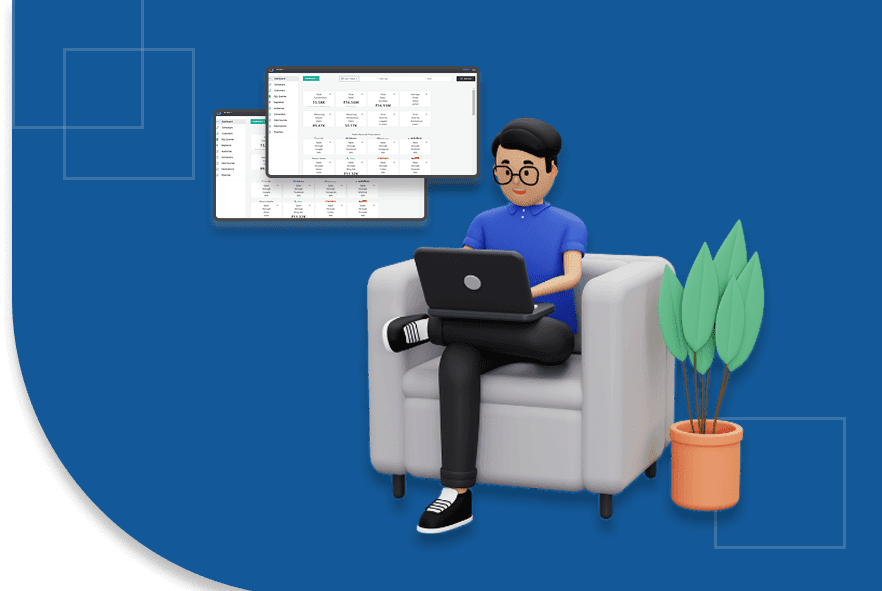Shopify Server-Side Tagging: Benefits, Setup, and Best Practices
What if the data you use to guide marketing spend, retargeting, and conversion decisions only tells half the story?
Over 50% of internet users in the U.S. now block ads, and more than 30% reject cookie tracking across sites. Additionally, browser restrictions are limiting third-party scripts, resulting in significant gaps in how events are captured on websites. These blind spots significantly impact performance metrics, audience segmentation, and attribution models essential for high-stakes campaigns. This growing data loss is more than a technical inconvenience for operations where every signal counts; it’s a revenue problem.
This blog explains how server-side tagging works on Shopify, why it closes these gaps, and how it helps businesses regain control of their marketing data.
What Is Shopify Server-Side Tagging?
Shopify server-side tagging refers to tracking data directly on the server, rather than relying on the browser. This approach shifts the data collection process from the client side, offering amplified control and greater accuracy.
Unlike traditional browser-side tracking, which relies on the browser to transmit data to third-party tools, server-side tagging manages data on the server. This enables more stability and improved data resilience, particularly in light of the increased privacy restrictions and limitations imposed by browsers and operating systems.
As the digital marketing environment evolves, server-side tracking presents an increasingly reliable solution. Let’s examine why this method has become so important for Shopify merchants.
Why Is Shopify Server-Side Tagging Important?
As privacy regulations tighten and browsers block cookies, traditional browser-based tracking becomes less effective. Server-side tagging moves data collection to the server, offering more reliable and compliant tracking. Below are some real-world insights showing the importance of this method for Shopify merchants.
1. Adapting to iOS 14+ Privacy Changes
iOS 14.5 introduced the App Tracking Transparency feature, limiting data collection for advertisers. Merchants using server-side tagging bypass these restrictions, ensuring accurate tracking for iOS users. This method improves data attribution and helps optimize marketing efforts despite the privacy limitations.
2. Evolving Privacy Regulations
Laws like GDPR and CCPA are creating more stringent data privacy requirements. Server-side tagging enables merchants to manage customer consent and data securely, ensuring compliance. This reduces the risk of fines and damage to reputation associated with non-compliance.
3. Ad Blockers Affecting Data
Nearly 30% of internet users block ads, affecting cookie tracking. Server-side tagging works around ad blockers by collecting data directly from the server, ensuring complete monitoring. This leads to more accurate customer insights and better-targeted advertising campaigns.
4. Cross-Platform and Cross-Device Tracking
Customers frequently switch devices while shopping, but traditional tracking methods struggle to capture this behavior. Server-side tagging connects customer actions across devices, creating a unified profile. This provides deeper insights into the customer journey, helping to optimize marketing strategies.
5. Mitigating the Risks of Data Loss
With the increasing use of cookie-blocking technologies, merchants risk losing valuable customer data. Server-side tagging ensures continuous data collection that is unaffected by browser limitations. This leads to more reliable insights and helps maintain the accuracy of customer journeys.
These insights show that by shifting the data collection process to the server, merchants can sidestep some of the most pressing issues affecting tracking today. Now, let’s explore how this transition can result in tangible benefits for your Shopify store.
Key Benefits of Server-Side Tagging for Shopify Merchants
Shopify merchants can gain significantly by adopting server-side tagging. By handling tracking on the server, Shopify stores benefit from increased data precision, improved performance, and streamlined compliance with privacy regulations.
The advantages include:
1. Better Data Accuracy
Server-side tagging eliminates many of the challenges that hinder traditional client-side tracking. Here’s how server-side tagging can drastically improve data accuracy:
- Minimized Data Loss: Data collection occurs on the server, minimizing data loss from ad blockers or browser restrictions. Client-side tagging often fails to send data due to these issues. Ingest Labs advanced server-side tracking ensures consistent data capture, even in restrictive environments..
- More Reliable Tracking: Server-side tagging is not subject to the same limitations that affect client-side tracking, such as browser cookie restrictions or JavaScript issues. This ensures that data is more reliable and comprehensive, improving the overall measurement of user interactions.
- Accurate Attribution: As more precise data is sent to analytics and ad platforms, attribution becomes more reliable. This enables a deeper understanding of the customer journey, which is crucial for optimizing marketing campaigns.
2. Enhanced Site Performance
Performance is crucial in e-commerce, and server-side tagging can significantly enhance the speed at which your Shopify store loads. Here’s how:
- Reduced Browser Load: Client-side tracking typically requires scripts to run within the user’s browser, which can slow down page load times. With server-side tagging, these processes are offloaded to the server, enabling the browser to focus on loading the page more quickly.
- Faster Page Load Times: Your site can load quickly by handling tracking and data collection on the server. Faster sites lead to better user experiences, higher customer satisfaction, and better conversion rates.
- Improved User Experience: Faster load times contribute to a smoother browsing experience, which is essential for retaining customers. A delay of just a few seconds in page load can lead to higher bounce rates and lost sales opportunities.
3. Extended Cookie Duration
Cookies are integral for tracking user behavior on your site, and server-side tagging offers advantages over traditional client-side cookies.
- Longer Cookie Lifespan: Server-side tracking allows you to store cookies on the server, which can persist longer than client-side cookies that are more easily deleted or blocked by browsers. This gives you a more consistent view of user activity over time.
- Improved Cross-Session Tracking: Extended cookie durations facilitate easier tracking of users across different sessions. With client-side tracking, cookies might expire or be deleted, resulting in fragmented data. Server-side cookies are less likely to be impacted by these factors.
- Better Multi-Channel Data: Longer-lasting cookies enable the tracking of user interactions across multiple devices and platforms. This is especially important for businesses looking to understand cross-device behavior and create more cohesive marketing strategies.
4. Privacy Compliance
Privacy concerns are growing worldwide, and with the increasing regulations such as GDPR and CCPA, businesses must comply with data protection laws. Server-side tagging offers a more streamlined approach to privacy compliance:
- Control Over Data: Server-side tagging gives you greater control over the data collected and how it’s processed. This enables better user consent management and compliance with data privacy laws, such as GDPR and CCPA.
- Easier Consent Management: Server-side tracking enhances consent management effectiveness. You can handle opt-in/opt-out requests directly on the server, ensuring that all data collection aligns with user preferences and privacy regulations.
- Reduced Risk of Non-Compliance: Centralizing tracking on the server makes it easier to implement privacy measures and maintain data integrity, thereby reducing the risk of non-compliance with increasingly stringent data privacy regulations.
The benefits of server-side tagging help Shopify merchants optimize their data collection strategies, stay aligned with privacy laws, and improve overall site performance. Let's now compare server-side and client-side tracking to highlight further why the shift is becoming increasingly important.
Shopify Server-Side Tagging vs. Client-Side Tracking
When considering tracking methods for your Shopify store, it's important to understand how server-side and client-side tagging differ. Each method has its strengths, but server-side tracking offers several advantages in today’s digital environment.
Here’s a comparison of the two methods:
| Aspect | Server-Side Tracking | Client-Side Tracking |
|---|---|---|
| Data Processing | Managed on the server, not in the browser | Managed in the browser, vulnerable to blockers and tag piggybacking |
| Accuracy | More accurate due to fewer disruptions | Less accurate because data can be blocked |
| Performance | Faster site performance with less browser load | Can slow down page load times |
| Privacy | Easier to comply with privacy regulations as there is greater control over entire data collection, storage and sharing. | More difficult to manage data privacy and consent |
As you can see, server-side tagging offers greater accuracy, faster performance, and better compliance with privacy laws. Many businesses are adopting this method to ensure their tracking remains reliable and future-proof.
Let’s now understand how much more data you can capture by implementing server-side tagging.
Unlocking Deeper Customer Insights with Server-Side Tagging
Server-side tagging amplifies the data you can collect, resulting in more accurate insights into customer behavior. This is especially important when using platforms like Facebook Ads and Google Ads, where accurate data is critical for refining advertising strategies and achieving better campaign results.
With server-side tagging, you can track a much wider range of customer interactions, providing a deeper understanding of your audience. Let’s take a look:
1. Event Tracking
Event tracking allows you to monitor specific customer actions on your website, providing insights into how users interact with your store.
- Track Specific Interactions: Capture actions such as product views, cart additions, checkout completions, and product purchases. This helps you understand the customer journey and tailor your strategies accordingly.
- Real-Time Data: Server-side tagging ensures the data is processed and transmitted in real time, making it more accurate and up-to-date than traditional client-side methods.
- Detailed Reporting: Server-side tagging enables you to generate detailed reports based on specific events, providing a clearer picture of user behavior and campaign performance.
By tracking these events more accurately, you can gain actionable insights into how visitors interact with your store, enabling you to fine-tune your marketing strategies.
2. Cross-Device Tracking
Cross-device tracking is indispensable for understanding user behavior across different devices and platforms. It enables the creation of a more complete and unified customer profile.
- Comprehensive Customer Profiles: Server-side tagging links user interactions across multiple devices, providing a seamless view of customer activity whether browsing on mobile, desktop, or tablet.
- Improved User Insights: By following the same user across devices, you can gain a deeper understanding of their preferences and behavior patterns, leading to more effective personalization and targeted advertising.
- Unified Attribution: Cross-device tracking ensures that conversions are accurately attributed to the correct touchpoints, regardless of the device used to complete the purchase.
With this improved tracking capability, your store can provide a smoother customer experience while gathering more holistic data about your users.
3. Enhanced Attribution
Attribution tracking enables you to understand which touchpoints in the customer journey contributed to a conversion, allowing for more effective marketing and resource allocation.
- Accurate Conversion Tracking: Server-side tagging ensures conversions are attributed to the correct channels, even when users switch devices or use different browsers.
- Better Campaign Performance: By attributing conversions correctly, you can identify the most effective marketing channels, which helps improve your ad spend ROI.
- Reduced Data Loss: Unlike client-side tracking, which can lose data due to cookie restrictions or ad blockers, server-side tagging helps ensure that data remains intact throughout the customer journey.
By improving attribution accuracy, you can make more informed decisions about where to allocate marketing resources and focus efforts on the channels that yield the best return.
Server-side tagging provides valuable, actionable data, leading to improved insights and more effective marketing campaigns.
To further optimize your server-side tracking and ensure accurate, real-time data integration across platforms, Ingest IQ offers seamless monitoring of all events in real time and data streaming directly to customer data platforms.
Now that we’ve discussed how server-side tagging enhances data capture, let’s proceed to implementing this strategy for your Shopify store.
Getting Started with Shopify Server-Side Tagging
With the right tools and a strategic approach, you can integrate server-side tracking into your Shopify store without disrupting your existing setup or workflows. By utilizing server-side tracking, you can ensure better data accuracy and a more streamlined process, all with minimal impact on your current operations.
Here are the key steps to get started:
- Utilize the Facebook Conversion API: This API integrates with Shopify for server-side tracking of Facebook Ads, ensuring accurate data collection and improved user interaction tracking.
To improve tracking and real-time data syncing, consider Ingest IQ, which supports server-side tracking for web and mobile applications, optimizing event monitoring and data streaming to customer data platforms (CDPs). - Explore Analytics Dashboard: Ingest IQ provides insights into your server-side tracking setup and analytics features to monitor performance. Ingest ID enhances tracking by providing first-party identifiers for unique visitors, allowing for accurate attribution and deeper insights into customer journeys, which in turn refine your marketing efforts.
- Test Without Disrupting Existing Tracking: Before transitioning, test server-side tagging with your current setup to compare results and ensure functionality without disrupting operations. Event IQ from Ingest Labs offers a unified solution for data integration, attribution and real-time event tracking, ensuring a seamless transition while maintaining data integrity.
Using these tools, you can gather more accurate and comprehensive data with minimal disruption to your existing system.
Final Thoughts
Server-side tagging is becoming a key tool for future-proofing your Shopify store’s data collection strategies. It offers better accuracy, compliance with privacy laws, and a smoother user experience, all while improving performance.
Adopting server-side tagging now ensures that your store can effectively manage future privacy restrictions and technological changes. You position your business for sustained growth and more efficient marketing strategies by getting ahead of the curve.
Ready to implement server-side tagging and take your Shopify store to the next level? Start Today!






